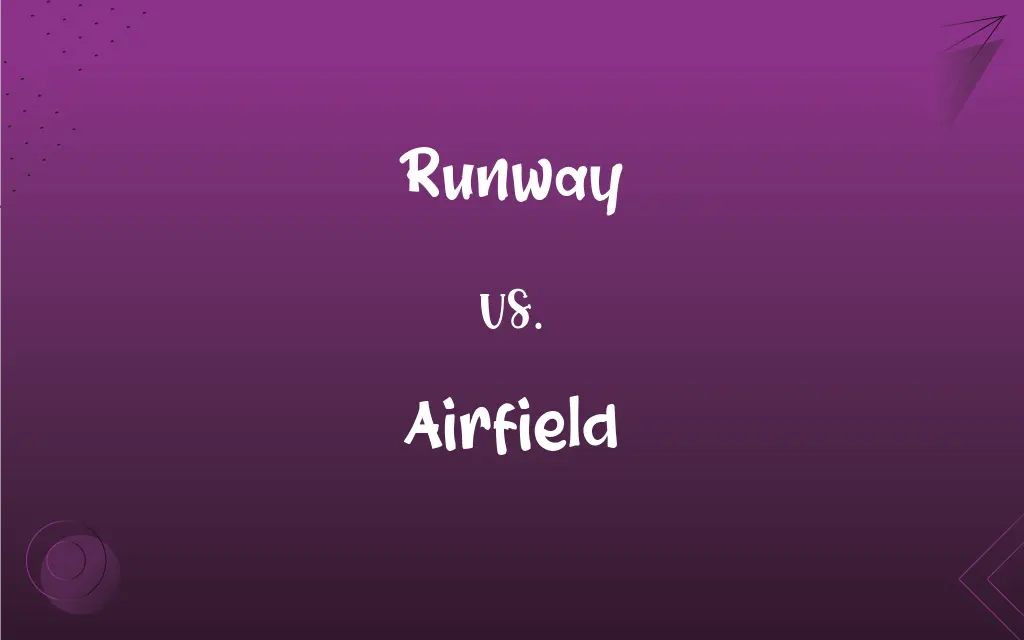Runway vs. Airfield: What's the Difference?
By Aimie Carlson & Janet White || Updated on May 30, 2024
A runway is a specific strip of land used for aircraft takeoff and landing, whereas an airfield encompasses the entire area, including runways, taxiways, and other facilities for aircraft operations.

Key Differences
A runway is a defined rectangular area on an airfield specifically prepared for the landing and takeoff of aircraft. It is marked with lines and numbers to guide pilots during these critical phases of flight. On the other hand, an airfield includes all the facilities needed for aircraft operations, including runways, taxiways, hangars, and control towers.
Runways are critical components within an airfield, designed to accommodate the speeds and weights of aircraft during takeoff and landing. They are typically made from concrete or asphalt to provide a durable surface. Airfields, however, comprise more than just the runways; they include all the infrastructure necessary for the maintenance, fueling, and storage of aircraft.
The length and width of a runway are dictated by the types of aircraft that use it, with larger aircraft requiring longer runways. Conversely, an airfield's size and complexity are determined by the volume and variety of aviation activities it supports, which can range from small private operations to large commercial hubs.
Runways feature distinct markings and lighting systems to ensure safe aircraft operations, especially in low visibility conditions. Airfields also have a range of lighting systems, but they serve a broader purpose, aiding in the overall management of aircraft movements on the ground.
A runway is a crucial, specialized part of an airfield designed specifically for takeoffs and landings, while an airfield includes all the necessary facilities and infrastructure to support comprehensive aviation activities.
ADVERTISEMENT
Comparison Chart
Definition
Specific area for aircraft takeoff/landing
Entire area for aircraft operations
Components
Markings, lighting systems
Runways, taxiways, hangars, control towers
Surface
Concrete or asphalt
Varies (includes runways and other facilities)
Function
Facilitate safe takeoff and landing
Support comprehensive aviation activities
Size Determination
Based on aircraft size/type
Based on volume/variety of aviation activities
ADVERTISEMENT
Runway and Airfield Definitions
Runway
A defined rectangular area for aircraft operations.
The runway was cleared of debris before the flight.
Airfield
An area encompassing facilities for aircraft operations.
The airfield includes multiple hangars and a control tower.
Runway
A surface made of concrete or asphalt.
The runway's new asphalt provided a smoother landing.
Airfield
A place where aircraft are maintained, fueled, and stored.
The airfield's maintenance crew worked on the jets overnight.
Runway
A critical component of an airfield.
The runway was resurfaced to handle larger planes.
Airfield
A site designed for the arrival and departure of aircraft.
The new airfield opened to accommodate more traffic.
Runway
A strip of level, usually paved ground on which aircraft take off and land.
Airfield
An installation that manages comprehensive aviation activities.
The airfield had advanced navigation systems installed.
Runway
A path, channel, or track over which something runs.
Airfield
A location with runways, taxiways, and support buildings.
The airfield was busy with both commercial and private flights.
Runway
The channel of a stream.
Airfield
An area of fields and runways where aircraft take off and land.
Runway
A chute down which logs are skidded.
Airfield
An airport or airbase.
Runway
A narrow track in a bowling lane on which balls are returned after they are bowled.
Airfield
(aviation) An open field designated for the taking off and landing of aircraft, but which, unlike an airport, does not necessarily have terminals or paved runways.
Runway
A smooth ramp for wheeled vehicles.
Airfield
A place where planes take off and land; an airport; - usually used of airports other than those with regularly sheduled commercial flights, such as those at military bases or small fields for private aircraft.
Runway
A narrow walkway extending from a stage into an auditorium.
Airfield
A place where planes take off and land
Runway
A defined, narrow section of land or an artificial structure used for access.
Runway
The usual path taken by deer or other wild animals, such as from a forest to a water source.
Runway
A narrow walkway (often on a platform) extending from a stage on which people walk, especially one used by models during fashion shows.
Runway
(athletics) In javelin, long jump, and similar events: a short track along which athletes can accelerate themselves for their jumps or throws.
Runway
(aviation) A section of land, usually paved, for airplanes to land on or take off from.
Runway
Hence, the number of months that a startup company can operate by using up its cash reserves.
Runway
A stream bed.
Runway
The channel of a stream.
Runway
The beaten path made by deer or other animals in passing to and from their feeding grounds.
Runway
A narrow platform extending from the stage into the audience in a theater or nightclub etc.
Runway
A strip of level paved surface where planes can take off and land
Runway
A strip of land for aircraft takeoff and landing.
The pilot aligned the plane with the runway before takeoff.
Runway
A pathway marked with lines and numbers for aircraft guidance.
The plane touched down smoothly on the runway.
FAQs
What is the primary function of a runway?
A runway's primary function is to provide a safe surface for aircraft takeoff and landing.
What facilities are included in an airfield?
An airfield includes runways, taxiways, hangars, control towers, and maintenance areas.
What is the role of an airfield control tower?
An airfield control tower manages air traffic on the ground and in the airspace around the airfield.
How does the length of a runway vary?
The length of a runway varies based on the types and sizes of aircraft it needs to accommodate.
What types of aircraft use runways?
All types of aircraft, from small private planes to large commercial jets, use runways.
Why are runways made from concrete or asphalt?
Runways are made from concrete or asphalt to provide a durable and stable surface for aircraft operations.
How are airfields designed for safety?
Airfields are designed with safety features like lighting systems, clear signage, and proper layout to ensure efficient and safe operations.
What lighting systems are used on runways?
Runways use lighting systems such as runway edge lights, threshold lights, and approach lights.
Can an airfield have multiple runways?
Yes, an airfield can have multiple runways to handle different types of aircraft and traffic volumes.
How are runways numbered?
Runways are numbered based on their magnetic azimuth (compass heading) rounded to the nearest 10 degrees.
What markings are found on a runway?
Runway markings include numbers, centerlines, threshold markings, and touchdown zone markers.
What maintenance is required for runways?
Runway maintenance includes regular inspections, resurfacing, and clearing debris.
How do pilots use runway markings?
Pilots use runway markings for alignment during takeoff and landing, ensuring they stay within the safe operational area.
What services are typically found at an airfield?
Services include air traffic control, aircraft maintenance, fueling, and passenger facilities.
Can airfields be used for non-aviation purposes?
Yes, airfields can sometimes be used for events, emergency services, and other community activities when not in use for aviation.
Are airfields only for commercial aviation?
No, airfields can support commercial, private, and military aviation.
What is the difference between a runway and a taxiway?
A runway is for takeoff and landing, while a taxiway is for moving aircraft between the runway and other areas.
Why is the location of an airfield important?
The location is crucial for accessibility, weather conditions, and proximity to populated areas or other infrastructure.
What are the environmental considerations for airfields?
Environmental considerations include noise pollution, land use, and wildlife management.
How do airfields support aviation activities?
Airfields provide infrastructure for takeoff, landing, aircraft storage, maintenance, and refueling.
About Author
Written by
Aimie CarlsonAimie Carlson, holding a master's degree in English literature, is a fervent English language enthusiast. She lends her writing talents to Difference Wiki, a prominent website that specializes in comparisons, offering readers insightful analyses that both captivate and inform.
Co-written by
Janet WhiteJanet White has been an esteemed writer and blogger for Difference Wiki. Holding a Master's degree in Science and Medical Journalism from the prestigious Boston University, she has consistently demonstrated her expertise and passion for her field. When she's not immersed in her work, Janet relishes her time exercising, delving into a good book, and cherishing moments with friends and family.































































